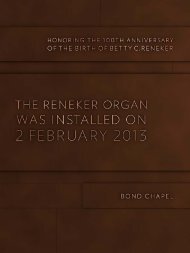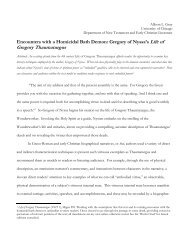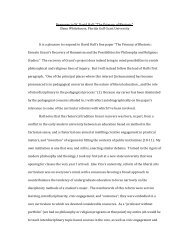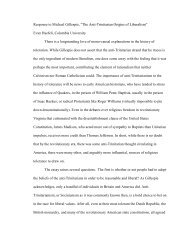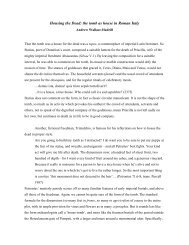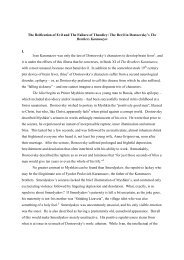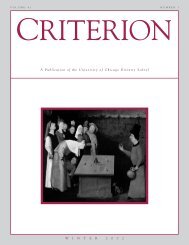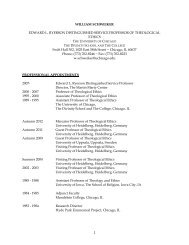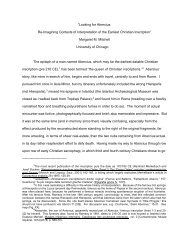THE ALTAR AND THE SCREEN: FILMMAKING AND WORLDMAKING S. Brent ...
THE ALTAR AND THE SCREEN: FILMMAKING AND WORLDMAKING S. Brent ...
THE ALTAR AND THE SCREEN: FILMMAKING AND WORLDMAKING S. Brent ...
You also want an ePaper? Increase the reach of your titles
YUMPU automatically turns print PDFs into web optimized ePapers that Google loves.
inadvertently offers some suggestions to religious studies scholars interested in film. His<br />
levels are:<br />
1. afilmic reality (the reality that exists independently of filmic reality)<br />
2. profilmic reality (the reality photographed by the camera)<br />
3. filmographic reality (the film as physical object, structured by techniques<br />
such as editing)<br />
4. screenic (or filmophanic) reality (the film as projected on a screen)<br />
5. diegetic reality (the fictional story world created by the film; the type of<br />
reality “supposed” by the signification of film.)<br />
6. spectatorial reality (the spectator’s perception and comprehension of a film)<br />
7. creational reality (the filmmaker’s intentions) 19<br />
I note these here to further evidence the multiple layers of reality that one must engage<br />
when dealing with film. It is not enough to encapsulate the narrative arc, and suggest<br />
some religious implications from a literary perspective; rather, the edited,<br />
cinematographic, and projected layers of film’s re-creation of the world must be taken<br />
into account.<br />
And while these seven layers are each of individual interest, the full implications<br />
complicate the more general analogous relations I am attempting here. One could, I<br />
suppose, discuss each of these layers in ways that relate to Clifford Geertz’s extensive<br />
definition of religion, defined as: “(1) a system of symbols which acts to (2) establish<br />
powerful, pervasive, and long-lasting moods and motivations in men by (3) formulating<br />
conceptions of a general order of existence and (4) clothing these conceptions with such<br />
an aura of factuality that (5) the moods and motivations seem uniquely realistic.” 20<br />
Souriau’s level 2 could relate to Geertz’s point 3, Souriau’s level 4 could relate to<br />
19<br />
These levels are quoted from Warren Buckland, The Cognitive Semiotics of Film (Cambridge, UK:<br />
Cambridge University Press, 2000), 47. See Etienne Souriau, L’Univers filmique (Paris: Flammarion,<br />
1953). Souriau’s work has not been translated into English, but good overviews include chapter 3 of<br />
Edward Lowry’s The Filmology Movement and Film Study in France (Ann Arbor, MI: UMI Research<br />
Press, 1985).<br />
20<br />
Clifford Geertz, “Religion as a Cultural System,” in The Interpretation of Cultures (New York: Basic<br />
Books, 1973), 90.<br />
16



